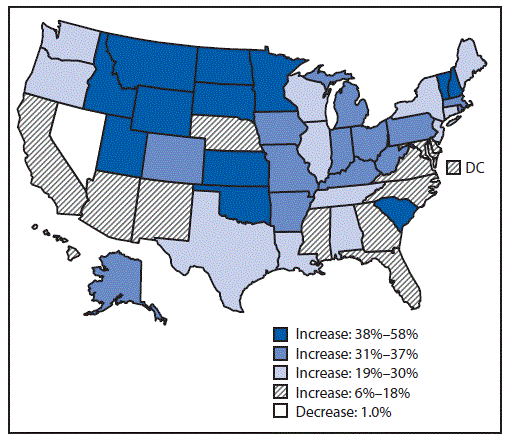Suicide rates in the United States have risen nearly 30% since 1999, and mental health conditions are one of several factors contributing to suicide, a compensable workers' compensation condition. Examining state-level trends in suicide and the multiple circumstances contributing to it can inform comprehensive state suicide prevention planning.
It has been reported that during 1999–2016, suicide rates increased significantly in 44 states, with 25 states experiencing increases >30%. Rates increased significantly among males and females in 34 and 43 states, respectively. Fifty-four percent of decedents in 27 states in 2015 did not have a known mental health condition. Among decedents with available information, several circumstances were significantly more likely among those without known mental health conditions than among those with mental health conditions, including relationship problems/loss (45.1% versus 39.6%), life stressors (50.5% versus 47.2%), and recent/impending crises (32.9% versus 26.0%), but these circumstances were common across groups. Stone DM, Simon TR, Fowler KA, et al. Vital Signs: Trends in State Suicide Rates — United States, 1999–2016 and Circumstances Contributing to Suicide — 27 States, 2015. MMWR Morb Mortal Wkly Rep 2018;67:617–624.
In New Jersey, "Although the act of suicide is specifically excluded as a compensable injury, the courts have interpreted the question of suicide in various ways over the years N.J.S.A. 34:15-7........More recently, the courts have adopted a different standard in cases involving suicide, namely the chain of causation test. This liberalization has occurred not only in New Jersey but in several other jurisdictions as well...... In 1981, the Supreme Court of New Jersey held that an employee's death by suicide is considered compensable under the Workers' Compensation Act of New Jersey where the suicide is shown to be the result of the employee's becoming dominated by a disturbance of mind caused by the employee's original work-related injury and its consequences, including severe pain and despair, which are of such severity as to override normal, rational judgment." Kahle v. Plochman, Inc., 85 N.J. 539, 428 A.2d 913 (1981). Gelman, Jon L, Workers’ Compensation Law, 38 NJPRAC 6.8 (Thomson-Reuters 2018).
Relationship problems and losses have been reported as having a significant impact on suicides. A physical health problem existed in 22.3% of reported suicides. Additionally, a job or financial problem existed in 16.2% of suicides. Determining the cause of the suicide can be revealed in notes left (34.5%), and actual disclosing intent (23.5%).
Prevention is a major key to reducing suicides. Suicidologists regularly state that suicide is not caused by a single factor. While suicide prevention is often oriented toward mental health conditions alone with regard to downstream identification of suicidal persons, it is necessary to treat all co-contributing medical conditions and prevention of reattempts. Comprehensive suicide prevention activities need to be integrated into workers' compensation care programs to address the full range of factors contributing to suicide.
…
Jon L. Gelman of Wayne NJ is the author of NJ Workers’ Compensation Law (West-Thomson-Reuters) and co-author of the national treatise, Modern Workers’ Compensation Law (West-Thomson-Reuters).
Update: 08.09.2018
Update: 08.09.2018

